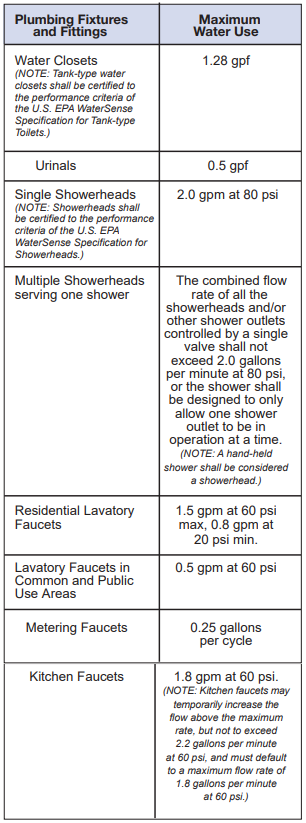The concept of water conservation has been recognized in the United States for more than 60 years. Back in the 1950s, the Water Resources Policy Commission published “A Water Policy for the American People” that read:
“We can no longer be wasteful and careless in our attitude towards our water resources. Not only in the West, where the crucial value of water has long been recognized, but in every part of the country, we must manage and conserve water if we are to make the best use of it for future development” (Wolff & Gleick, 2003, p. 16).
It was very clear to the American people early on that water is an important resource and shall be managed well and conserved. In the last couple of decades, the U.S. government began taking an active role in enforcing the use of water-saving technology in residential homes and commercial buildings. To encourage the water saving, many rebates have been given to consumers for switching to products that are use less water, which assists in the transition before enforcement begins.
As the leading third party plumbing product certifier in North America, IAPMO R&T has always devoted resources to monitor these continually evolving requirements to ensure that manufacturers are kept up to date. It has always been IAPMO R&T’s goal to ensure a seamless transition for manufacturers that keeps them ahead of the game.
The following is a quick guide to understand major requirements related to water-saving technology used and/or enforced in the United States:
WaterSense®
WaterSense is a voluntary partnership and labeling program launched by the United States Environmental Protection Agency (U.S. EPA) in 2006 designed to reduce municipal water use across the country. Through the use of the WaterSense label, consumers can easily identify products that use 20 percent less water and perform well. In order to obtain this label, such products shall be tested for efficiency and performance to the WaterSense specifications and certified by a third-party licensed certifying body, such as IAPMO R&T.

To date, there are seven WaterSense® product specifications released by the U.S. EPA with more to come. Figure 1 provides a summary of those specifications along with the water consumption requirements.
Although this program is voluntary, many jurisdictions across the country started to adopt these requirements and make them mandatory. Among those jurisdictions are New York City and the states of Georgia, Colorado, and Massachusetts. To learn more about the WaterSense® program, please visit the WaterSense® website at http://www.epa.gov/watersense.
The U.S. Department of Energy (DOE)
The U.S. Department of Energy (DOE) is authorized by the Energy Policy and Conservation Act of 1975 (as amended) to enforce compliance with the energy and water conservation standards established for certain consumer products and commercial and industrial equipment.
DOE has published certification, compliance, and enforcement regulations for the affected products and equipment in the Code of Federal Regulations (CFR) at 10 CFR Part 429. These regulations describe how manufacturers must establish certified ratings based on conducting DOE test procedures on a sample of units of a given basic model and subsequently apply DOE’s statistical sampling plans. The regulations also describe how manufacturers must submit certification reports to DOE, and how manufacturers must maintain records underlying the certification. Finally, the regulations describe processes for DOE-initiated testing and enforcing compliance with the certification provisions and the energy and water conservation standards.
DOE regulates the following plumbing products: water closets, urinals, showerheads, faucets (lavatory and kitchen faucets), and commercial pre-rinse spray valves. The following are the entities that DOE regulates: manufacturers (including importers) and private labelers. Failure to comply with the regulations could result in civil penalty. To learn more about these regulations, please visit DOE’s website at http://energy.gov/eere/buildings/applianceand-equipment-standards-program.

CALGreen
Many people have heard about CALGreen, but what is it? CALGreen is essentially a more stringent building code that requires, at a minimum, that new buildings and renovations in the state of California meet certain sustainability and ecological standards. This became effective on Jan. 1, 2011. This means that in the state of California every new building built after Jan. 1, 2011, must meet a certain baseline of efficiency and sustainability standards, raising the bar for what is allowable. CALGreen was later revised in 2013 with updated requirements that became effective on Jan. 1, 2014.
CALGreen encourages sustainable construction practices in the following categories:
• Planning and design
• Energy efficiency
• Water efficiency and conservation
• Material conservation and resource efficiency
• Environmental quality
Concerning the water issue, CALGreen requires a 20 percent reduction of indoor water use. Figure 2 below provides a quick summary of current CALGreen Maximum Water Use for plumbing fixture and fittings.
CALGreen also regulates outdoor water usage. It requires irrigation controls to be weather- or oil moisture-based and automatically adjust irrigation in response to changes in plants’ needs as weather conditions change, or have rain sensors or communication systems that account for local rainfall. For more details about CALGreen, please visit California Building Standards Commission website at http://www.bsc.ca.gov/.
California Energy Commission (CEC)
The California Energy Commission (CEC) is the state’s primary energy policy and planning agency. It was established by Legislature in 1974 and has responsibility for activities that include forecasting future energy needs and promoting energy efficiency and conservation by setting the state’s appliance and building energy efficiency standards.
On April 1, 2015, the California Gov. Jerry Brown issued Executive Order B-29-15 to improve the efficiency of water appliances due to severe water shortages caused by prolonged drought. As a result, CEC adopted the new emergency standard affecting toilets, wall-mount urinals, kitchen and lavatory faucets, and showerheads. The standard becomes effective in tiers, with residential lavatory faucets the first that needed to comply with the standard last September. The affected products shall be certified with CEC by the specified deadline before the products can be legally sold in the state of California.
IAPMO Green Plumbing & Mechanical Code Supplement (The Green Supplement)
The IAPMO Green Plumbing & Mechanical Code Supplement (The Green Supplement) is a separate document that establishes requirements for green buildings and water efficiency applicable to plumbing, mechanical, and solar energy (both hydronic and photovoltaic) systems. The Green Supplement serves as an adjunct to the Uniform Plumbing Code (UPC®) and the Uniform Mechanical Code (UMC®).
With regard to water efficiency and conservation, it requires at least 20-percent reduction in water use. It covers the following products:
• High efficiency plumbing fittings, fixtures, and appliances
• Water softening equipment
• Boiler make-up water
• Occupancy specific provision in restaurants and medical facilities
• Cooling towers and evaporative coolers
Several jurisdictions across the country, such as city of Lincoln, Neb., the states of Georgia and Oregon, and the city of Chicago, have adopted provisions from the Green Supplement in their efforts toward increased water conservation and energy efficiency. To learn more about the Green Supplement, please visit https://www.iapmo.org/we-stand.
As you can see, there are many similarities between each of the above requirements. Most started as voluntary and as technology became proven were adopted as mandatory. These requirements are continually reviewed and updated as new technology allowing same/better performance and using less water is introduced.
Going back 60 plus years ago when the concept of water conservation was first introduced, it was indeed a life-changing concept. More people nowadays realize the value and importance of water. In closing as food for thought, perhaps water is the new oil; thus we shall conserve and manage it well for our future generation.
To learn more on how you can obtain certification to any of these water conservation requirements, please contact IAPMO R&T via e-mail at info@iapmort.org or via toll free 877-4UPCMARK

Jin Luo
Last modified: December 29, 2022
